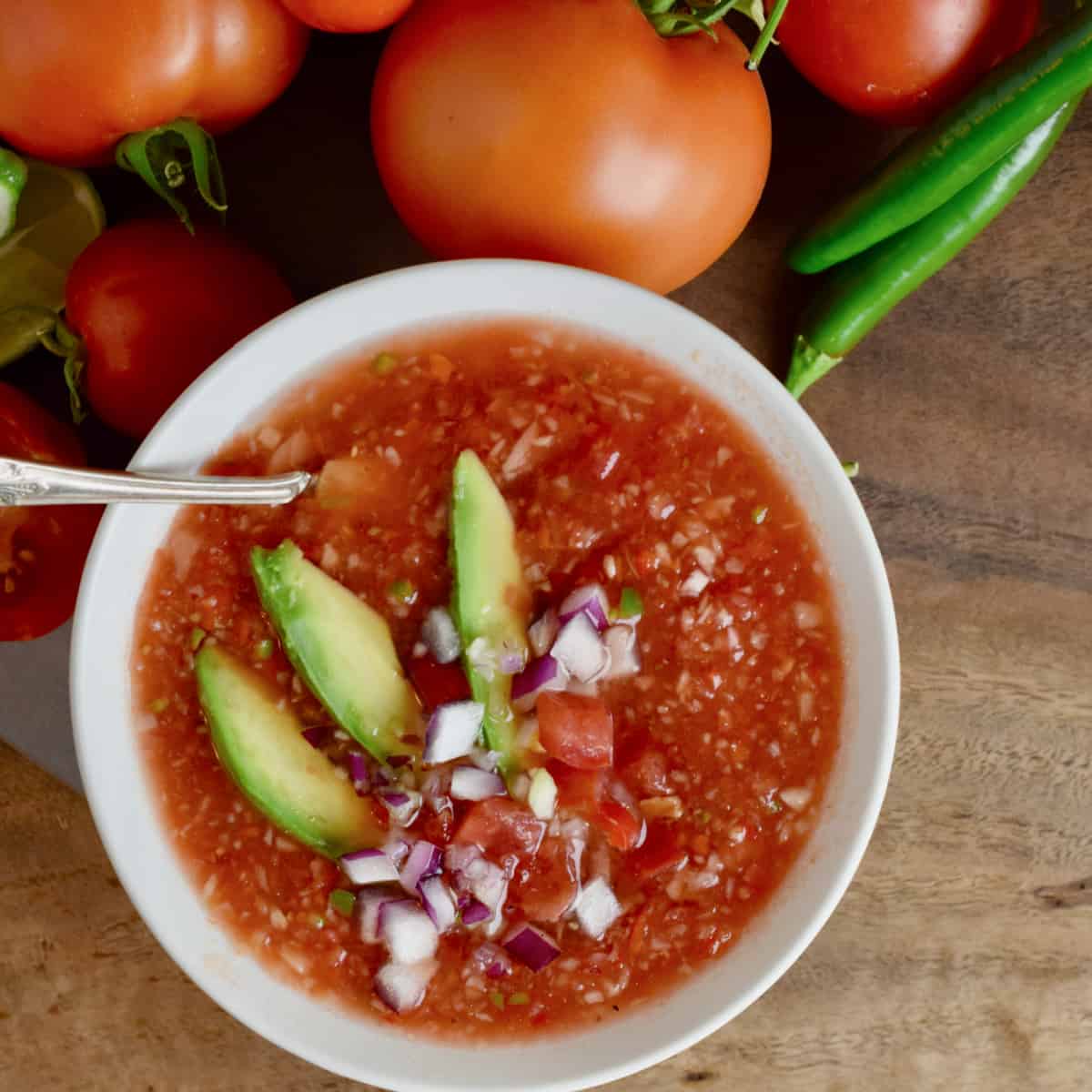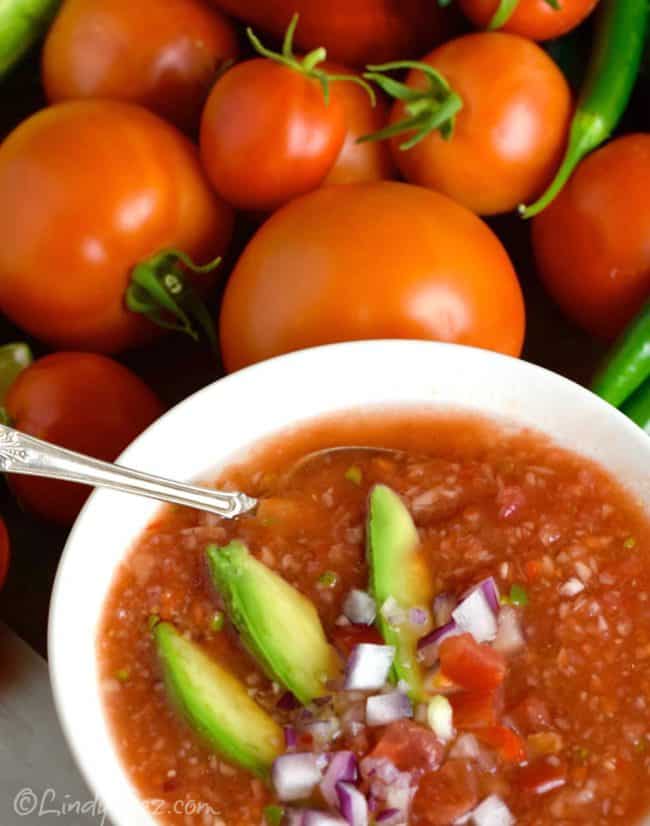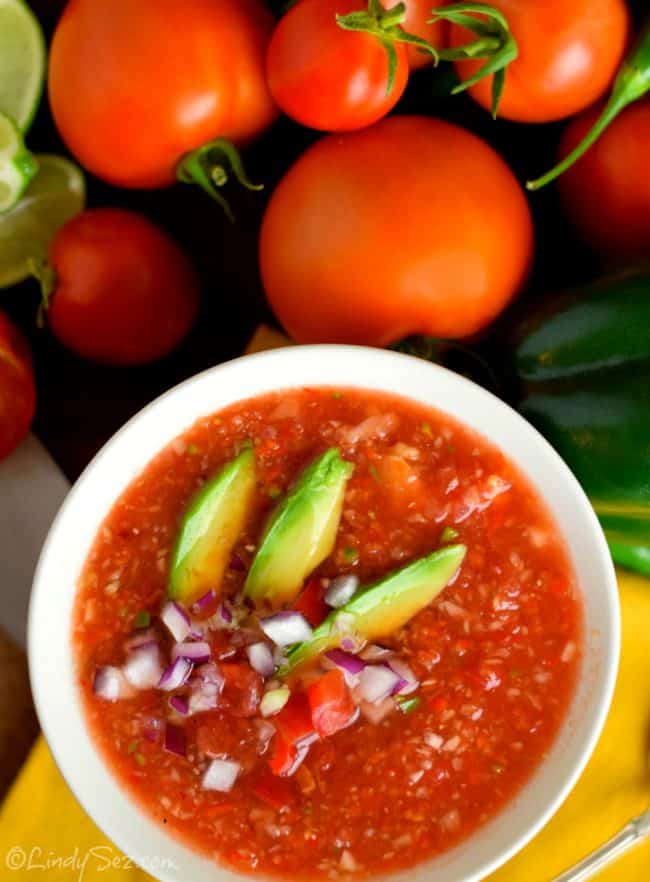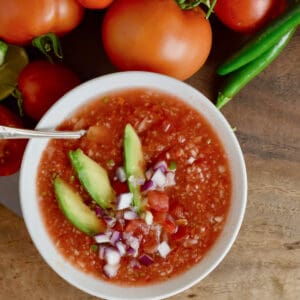"This recipe for Gazpacho is a well-balanced slightly chunky version combining fresh garden tomato, cucumber, peppers, along with the acid from lemon and lime juice. It's a perfect summer soup, light and refreshing." While it can be consumed immediately, it's best left overnight or better for three days!"

The making of the Best Chunky Gazpacho
I don't like Gazpacho.
Or at least, I didn't like Gazpacho.
The first time I was served a "Gazpacho" a dish that originated in Spain, it was a thick, tomato, and bread-based "soup". And I use the term soup loosely. It was a combination of soggy bread and tomato juice. With a bit of garlic and olive oil. I liked neither the flavor nor the texture.
Second time. Fully blended Gazpacho. Really good tasting V-8 juice. Add me a shot of vodka and call it a Bloody Mary.
So I stopped ordering it or thinking about it.
Until BB and I went into a little bar/cafe in New Orleans for a bite before we went to our lunch. That's what we food people do. Eat something at place A before we head over to place B to eat. It's the only way to dine.
As we sat and looked over the menu, BB's eyes lit up as he saw they had Gazpacho on the menu. A nice light little nosh before lunch.
"I'm not a big fan of Gazpacho," said I.
"I LOVE Gazpacho, and I order it ALL THE TIME," said he.
Holy cow, do I even know this man?
So we order a bowl and I am impressed. This is a good Gazpacho. Nice chunk. Full flavor. Some heat. Not overly tomatoey. Good balance of acid.
"I love Gazpacho".

My garden is ripe with red tomatoes, beautiful sweet juicy cucumbers (Chinese Snake, burpless and never bitter), and plenty of peppers. So what else to make, but Gazpacho?
This recipe is not too chunky, and not too liquidy. It has a great balance of acid, coming from both lemon and lime juice, subtle heat from the peppers, but it's the beautiful fresh tomato and sweet cucumber that makes the flavors sing.

To use or not to use Olive Oil
Many recipes use ⅓ to ½ cup of olive oil. I chose not to use olive oil except as a finishing touch. This keeps the soup not only lower in fat and calories, but also allows the fresh flavors of the vegetables to shine through without being muddled by oil.
A little can can help
You may note I did add a can of tomato juice. My vegetables were so fresh and juicy that after the soup was ready, I thought it a little thin. I wanted to add a little more density to give a better mouthfeel. So I tasted, added a bit of tomato juice, tasted again, and found the canned juice did not disrupt the freshness but did give me the mouthfeel I wanted. You can add it, or not. But I would.
Peeling Tomatoes
My mother taught me to peel tomatoes by making an X on the root end with a sharp knife, then plunging them into boiling water for a couple of minutes until the skin loosened. We would then remove them from the water, let them sit for a minute or two to cool, then proceed to remove the skins from the still-warm tomato. By the time we got to the last tomato, it was pretty soft. A hot tomato will continue to cook.
As time went on, I thought...why not do what I do with all my other vegetables when I blanch them? Shock them in ice water? So I did that for a while. Boil the tomato, remove it from the hot water, shock it in iced water, then peel. Better results for the condition of the tomato but now I had two vessels of water to dispose of.
A local farm-to-table food writer here in Sonoma County, Michelle Anna Jordon, wrote in her column one day that she peels her tomatoes by holding them over an open flame until the skin of the tomato just popped. So I thought I would give that method a try and it's now the method I use all the time. Not only does the tomato not get any dilution in flavor from being in boiling water, but the skin also pops well before the tomato is heated. So you can easily remove the skin from your still "raw" tomato.
And no pots of water to take care of.
Easy - I like easy.
This soup is all about the vegetables so -
- Use fresh, farm-fresh, not winter grocery store, tomatoes. Summer tomatoes. From your garden. From the Farmer's Market. OR if that is impossible, use a quality canned Italian tomato. Yes, that's right. I would prefer canned to a grocery store tomato. While I peeled* them, I did not seed them.
- The sweetness of the cucumber helps tame the acids from the tomato. So again, as fresh a cucumber as you can get. In this case, if you can't get a farm or garden-fresh cucumber, then I would use the regular burpless cucumber in your store. More flavor than the Japanese or hothouse variety. Peel and seed.
- Red onion, due to its sweet nature, is preferred over yellow or white. If you don't have red, use a sweet onion such as Vidalia.
- When it comes to the bell pepper, red is also preferred due to its sweeter flavor. Yellow or orange could be substituted, but the color of the finished soup will be compromised a bit. Green should not be used, the flavor is just ... too green.
- Serrano peppers are perfect. But if you can't or don't want to use them, jalapeno or another hot pepper could be substituted. As always, I recommend you taste a bit of your pepper before deciding how much, or how little, to use. I had one super hot pepper and one semi-hot. Together, they worked. Of course, I did have the optional diced pepper to add at will, so everyone could adjust the heat to their own taste buds.
- Many recipes I viewed used vinegar and or sherry as the acid in the soup. I thought these flavors to be too strong and really change the freshness of the ingredients. So I tried lemon and lime juice (honestly I had one of each so I used one of each.) I loved the bright acid this brought without changing the freshness.

Gazpacho
Don't rush the standing time of this Gazpacho
This fresh Gazpacho loves to hang out in the refrigerator. It needs time to allow all the flavors to really get together and make a party. A few hours, at least, but better a day or two or three.

Fresh Chunky Style Spicy Gazpacho
Equipment
- Blender or
Ingredients
- 6 large ripe red tomatoes peeled* and chopped (about 3 - 4 cups)
- 1 ½ cups chopped peeled and seeded cucumber
- ½ cup diced red onion
- 1 red bell pepper seeded and diced (about ¾ cup)
- 2 Serrano peppers diced (or other hot pepper, such a jalapeno) or to taste
- 1 large clove garlic pressed or finely minced
- 1 6-ounce can tomato juice
- Juice from one lime
- juice from one lemon
- 4 dashes Tabasco
- Salt to taste
- Garnishes optional
- Diced avocado
- Diced fresh cucumber
- Diced red onion
- Diced tomato
- Diced red bell pepper
- Fruity Olive Oil
- Lime wedges
- Additional Tobasco
Instructions
- Place the tomato, cucumber, onion, red bell pepper, Serrano pepper, and garlic along with a good pinch of salt, into the work bowl of a food processor, process, using on/off pulses until the contents are liquidy but not liquified...you still want some texture. Add the can of tomato juice along with the lime and lemon juices with a few dashes of Tabasco; pulse once or twice until mixed in, taste, and add salt as needed. Pour into a covered container and allow to sit in the refrigerator for a few hours at least to allow the flavors to develop. When ready to serve, stir and taste for heat, and salt. Adjust to taste. Serve in chilled bowls with garnishes as desired.

Leave a Reply